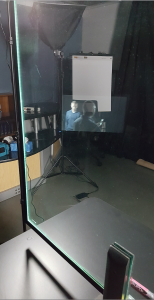Use a learning glass to deliver engaging lectures

The “Learning Glass”, sometimes called a Lightboard, is a large piece of glass ringed by LED lights. When the fluorescent marker is applied to the surface, the ink catches the light from the LEDs and glows clearly and brightly. Instructors can take advantage of this and draw from behind the glass, allowing the audience to see them and their written work at the same time. How do you read the writing from the other side of the board? Simple, just flip the image.
We recently installed a Learning Glass unit at UAF CTL. Response to our unit has been positive. Several instructors created videos that are already being used in this semester’s courses including biology and art. Northwestern, San Diego State University, and the University of Florida have studios with a Learning Glass and years of experience behind them. What is special about videos created with the Learning Glass? Why is the product any different from a classroom lecture, a talking head video, or a screencast?
First, the traditional mode of delivery–writing on a board in front of you–helps instructors overcome unease about being in front of a camera.1 Many of the hard sciences that rely on diagrams and models to convey complex information are well-suited to this mode.
Second, and most importantly, a Learning Glass video collapses the perspectives of the viewer and presenter into one shared perspective. You watch the presenter’s face and body language while looking at the content they are creating. Students like it because they are watching a real person communicating to them while getting visual and textual reinforcement of the content. Instructors like it because it allows them to communicate in a direct and natural way while putting forth their best self to the students.
Third, the Learning Glass is a supportive medium, like a podium or a whiteboard. Instructor interaction with the material is natural and obvious. This lends itself well to videos with two subjects discussing a topic leading to shared understanding. The PBS Newshour recently broadcast a Learning Glass segment that showcases this dynamic.2
Professor Matt Anderson of San Diego State University created his Learning Glass unit because he wanted to solve the problem of perspective in both the traditional and online classroom. He wanted students to see “all the little nuances, see exactly any mistakes I made, see where I’m thinking a little bit longer about some things and not others.” Essentially, he wanted to not only capture instructor presence but enhance it.
The recommended practices for creating a Learning Glass video are no different than making any kind of instructional video. Plan ahead. Plan out your delivery with an outline or a sketch. Do one or two takes. Keep it short.
Quick Tips for using learning glass
- One topic, one board. If you can’t fit it on the board, then you can’t fit it in a single video.
- Plan your talk so you know where you are going to be drawing on the lightboard. If you need to erase much, it’s probably too long.
- Do not wear light or bright clothing. It obscures the bright text when you are standing behind it. Darker clothing is best. Deep blue is really nice.
- No text on clothing. It appears reversed in the actual video.
- Expectations for videos are higher than for classroom lectures, but you needn’t strive for perfection. Good enough is good enough. Remember that foibles or inconsequential mistakes are humanizing.
See the video highlighting these tips and other Learning Glass uses: https://ecampus.uaf.edu/go/learningglasstt .
Interested in using the unit, or producing any other video in our shared media studio, please contact Owen Guthrie or Sean Holland at UAF CTL.
REFERENCES
- Peshkin, M., Birdwell, J., Inzko, H., Bobbert, C. and Evans, E. (2014). 7 Things You Should Know About Lightboard. EDUCASE. Retrieved September 8, 2016
- PBS NewsHour. (2016) For Trump, China is at the heart of U.S. economic problems.. Retrieved September 8, 2016
- Anderson, M. (2016). The Learning Glass with Matt Anderson.. Retrieved September 8, 2016


[…] Learning Glass […]